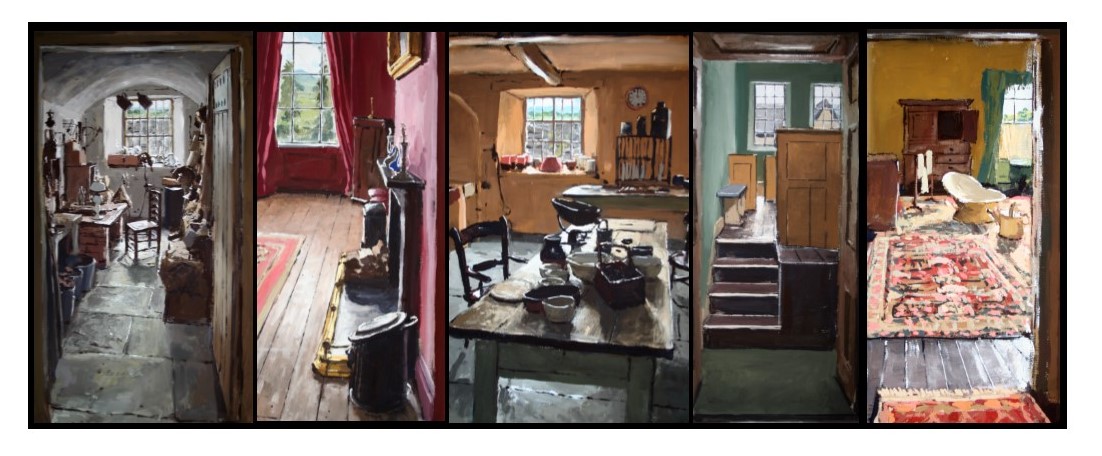The name given to the tight trousers worn by some Regency gentlemen, such as the notorious Beau Brummell and his ‘dandy’ followers, as they showed off their leg muscles.
The Judge’s Lodging brings Napoleon to Powys!
PRESS RELEASE

Napoleon & Powys is the exciting new exhibition recently opened at The Judge’s Lodging, focussing on the effects of the Napoleonic Wars, which 200 years ago were brought to a conclusion at Waterloo.
This exhibition brings together for the first time objects from museums and private collections throughout Powys. There is a stunning 11th Light Dragoons uniform, worn during the conflict by a Brecon man, Waterloo medals, weapons and artwork made by French prisoners all on display. Two British Light Cavalry sabres on display have a particularly gruesome story about the devastating damage they could inflict on the enemy. You can seen souvenirs from the battlefield of Waterloo and of the Napoleonic Wars’ greatest figures – a lock of Wellington’s hair, a piece of Nelson’s Victory and there is even a piece of wallpaper allegedly from Napoleon’s bedroom, thought to have contained the arsenic that killed him – alas, dramatic although this story is, it is quite conclusive now that the French Emperor in fact died of stomach cancer, but what a story! The exhibition features objects from six museums: the three Powys shire museums, the Regimental Museum of the Royal Welsh, Herefordshire Museum Service and The Judge’s Lodging’s own collection.
It is easy to think that such a quiet part of the UK could not possibly have seen much change to their lives throughout over twenty years of fighting, which ranged from Egypt, throughout Europe, and especially through the Peninsular, before culminating in the Allied Army meeting Napoleon’s forces in Belgium. But to many people in the shires that now make up Powys, these wars were an integral part of their lives, from the men who enlisted and fought, to those who lived in one of the five towns throughout Montgomeryshire and Brecknockshire who housed French prisoners.
There is a special focus on men from Presteigne who fought in the conflict, including a major section dedicated to Thomas Burch, whose gravestone can be seen just yards away from the museum in St Andrew’s churchyard. Thomas was wounded at the Battle of Quatre Bras during the Waterloo campaign, but returned to the town to become a larger than life figure as landlord of the Bull Inn.
There were those who keenly followed the war news and how could Presteigne residents not have heard that the country’s best known- prisoner of war, Napoleon’s own brother Lucien, was living just twenty miles away in Ludlow! There is even a criminal case highlighted in the exhibition where a local woman was transported to Australia for her forgery of the paper money, being produced as a direct result of the wars’ costs on Britain.
Gaby Rivers, The Judge’s Lodging’s curator, says ‘This is real honour to be able to share the stories of these people; see their clothes, their medals and the effects this conflict had on them. We are so tremendously excited to be able to bring these stories and objects together like this and can’t wait to share it with visitors – it is a very special exhibition.’
Napoleon & Powys is open now and will run until 30th September. The museum is open 10-5 Tuesday – Sunday and Bank Holiday Monday. Admission to this exhibition is free.
This exhibition has some fascinating stories and visually stunning objects. If you would like to send a photographer, they would be extremely welcome. Alternatively, we could arrange for photographs taken ourselves to be sent to you.
A further press release will be issued in a few weeks concerning the soldier Thomas Burch, whose life is far too colourful to fit in here – as a taster, he was one of the ferocious 79th Cameron Highlanders and appears to joined the army, lying about his age, when he was only 12 years old!
Please do contact me on info@judgeslodging.org.uk or call 01544 260650 to arrange or ask for any further details.
Gaby
Gabrielle Rivers
Senior Museum Curator
The Judge’s Lodging
Presteigne
Powys
LD8 2AD
Tel: 01544 260650
Email: info@judgeslodging.org.uk
